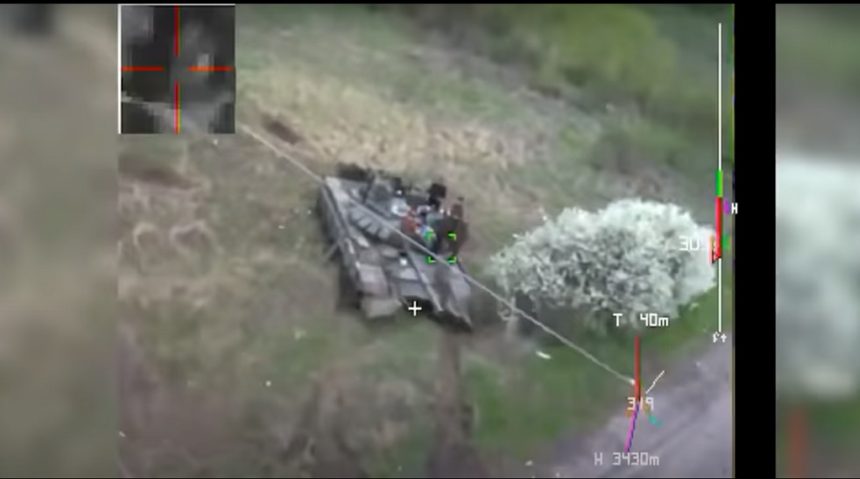The US-made “suicide drone” is shown during its dive toward a Russian T-72 tank, few weeks after photos of the first expended Switchblades were posted online.
As expected, the first video evidence of the Switchblade loitering munitions being used in Ukraine just emerged online. The video shows the US-made “suicide drone” as it descends toward the target during an attack against a Russian T-72 tank, which was seemingly parked beside a road and with its crew standing on the turret.
The description of the video says that the attack was performed by SSO operators, the Ukrainian special forces. While the accuracy of the description of the video can’t be verified, it mentions that the Russian soldiers “were drinking alcohol while sitting on the armor of their tank”, when the drone flew straight into the tank and caused “irreparable damage”.
Video of Ukrainian SSO employing a US Switchblade loitering munition against a Russian T-72B3 tank. https://t.co/jtwzdMkJMy pic.twitter.com/fj8BAqJrgl
— Rob Lee (@RALee85) May 24, 2022
As the munition got closer to the T-72, it appears that the crew was indeed on the turret and it might have been the real target of the attack. Even if the Switchblade’s video feed cuts off just a few seconds before the impact, a second video from a position overlooking the area seems to show the munition impacting the tank or its immediate vicinity.
Some of the comments below the video posted online argue that the munition struck a powerline (which can be clearly seen in the last few seconds of the video feed) and was deflected off the target, however the grainy image from far away doesn’t allow to verify with certainty if the T-72 sustained a direct hit or if it was just hit in the side. However, we should not rule out the possibility of the Switchblade being able to hit the tank even in the event it struck the power lines and it lost its folding wings, as the kinetic energy might have been enough to reduce the effects of the deflection in those few remaining meters of flight.
#Ukraine: The first ever appearance of a US-supplied Switchblade 300 loitering munition (Kamikaze Drone) in combat in Ukraine – these remains were recovered by Russian forces in #Kharkiv Oblast. pic.twitter.com/gPhL5m9idc
— 🇺🇦 Ukraine Weapons Tracker (@UAWeapons) May 6, 2022
The loitering munition used in the video is said to be the Switchblade 300, designed for pinpoint strikes on personnel. These loitering munitions are part of an aid package from the United States which includes both the Switchblade 300 and the 600, with the latter meant to destroy primarily tanks and other armored vehicles.
The Switchblade 300 has a range of 10 km and an endurance of just 10/15 minutes, but it has the advantage of being easily transported by a soldier in a backpack, weighting just 2.5 kg. On the other hand, the Switchblade 600 is much larger, weighting more than 22 kg, but it also offers improved performance with a range of more than 90 km and an endurance of more than 40 minutes.
According to the US media, US government providing Ukraine with Switchblade 300 killer drones — cutting-edge guided missiles that could accurately target Russian vehicles and positions from 10km away.
1/ pic.twitter.com/13Le72wGS8
— 𝔗𝔥𝔢 𝔇𝔢𝔞𝔡 𝔇𝔦𝔰𝔱𝔯𝔦𝔠𝔱 (@TheDeadDistrict) March 16, 2022
The Switchblade loitering munition uses a color camera and GPS locating to identify, track, and engage targets, while sending a live video feed to the operator and allowing to abort the attack if the situation requires it. The warhead has an explosive charge equivalent to a 40mm grenade, which is considered suited to destroy light armored vehicles and personnel.
The Switchblade is launched from a tube with the use of compressed air. It is then propelled by an electric engine, allowing a very silent flight which, together with the small size, makes it extremely difficult to detect or try to intercept the loitering munition. The munition can fly to its target at 85 knots (157 km/h).
The larger Switchblade 600 loitering munition carries a warhead based on the Javelin ATGM, designed to neutralize armored vehicles. Because of this the weight increased, but it is man-portable and can be set up in 10 minutes. Together with the greater range and flight time, the Switchblade 600 also has a higher speed, at it can fly up to 100 knots (185 km/h).









